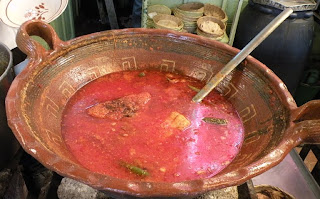
Comida Corrida. You will see these words implying ‘cheap hot lunch’ all over town in fondas, those little mom & pop eateries that cater to working class Mexicans looking for an economic home-cooked repast. The literal definition of a fonda is a “tavern, inn or small restaurant.” But like the terms bistro and trattoria, the meaning has become blurred. There can be high end fondas like the Fonda del Refugio, an elegant restaurant with white tablecloths. But here I refer to the simple kind attending to Marx’s lumpenproletariat. At around 2PM, Latin lunch time, these places fill to capacity. Some - presumably the good ones - have lines in front. It’s a Mexican custom which happily refuses to succumb to the invasion of US-style fast-food down-the-hatch-and-pay slop houses. People in a hurry stop at street stalls. Mc-chains which tend to be a lot more expensive, languish half empty.

The term comida corrida implies an economical mid-day meal served, in the civilized European manner, in three or four ‘tiempos’ or courses. The word ‘corrida’ which literally means a ‘run’, here refers to the fact that the dishes are brought out succesively; it does not, as is sometimes supposed, allude to the ‘corrida de toros’ or bullfight. Comidas corridas are often run by women, making those who don’t have access to a mother or grandma feel right at home. The show opens with a sopa aguada, which, as it sounds, is a soup. It is then followed by a sopa seca or ‘dry soup’ – rice (with or without beans) or sometimes, pasta. The curtain then rises on the plato fuerte or guisado (prepared dish) most often meat cooked in a sauce accompanied by tortillas. The variety of main dishes is infinite, ranging from plain milanesas to vegetable fritters. A dessert may be added, often an unremarkable jello or flan. Aguas preparadas, made from fresh fruit with water and sugar added, are provided (normally at no extra charge) in a pitcher or by the refillable glass.
There are thousands of comida corrida joints in the city. Many serve dull, cheap but filling food – lots of starch, a bit of chewy meat in watery salsa. But a few stand out. And there are gems waiting to be discovered. It would take several lifetimes to try them all; everyone has his or her favorite. Send me yours - here are a few of mine.
 Doña Juana, Mercado San Juan
Doña Juana, Mercado San JuanCalle Ernesto Pugibet, Centro
(Metro Salto de Agua)
Doña Juana is the San Juan market's best cook. Her stand is across from La Catalana--look for no. 283 on the green column. A sharp cookie with eyes at the back of her head, Doña Juana leaves no details unattended – your drink will be refilled and tortillas replenished. Her food is hearty, spicy, and varied. Recently on offer were huevos ahogados (literally ‘drowned eggs’) and cochinita pibil, the ruddy yucatecan classic. And at 32 pesos you can't beat the price. On Saturday she does one of the city’s best pozoles, mischievously trying to fatten you up with crema-slathered tostadas.

La Olla de Abundancia, Mercado San Juan de los Arcos de Belén
(nearby but not the same as the San Juan market above)
Corner of Izazaga and López, Centro (metro Salto de Agua)
Open daily
Recognizable by its red counters, this sprawling fast lunch counter serves just about every Mexican classic and their 35 peso comida corrida is indeed abundant. I like the enchiladas verdes, but you never know what will be on the extensive menu.
Las Costillas

Corner of Juan Escutia and Pachuca, Condesa
Open Monday-Saturday, closed Sunday
This is a neighborhood taquería specializing in carnes a la parrilla or grilled meats. The fragrance of charred meat, garlic and hot tortillas that greets you on entering is maddening. A little ameuse-bouche of black beans starts things rolling here, followed by the usual soup and my favorite, tacos de costilla (rib) which sing of smoke, fat and everything porcine-good.
The Mercado Medellín ‘food court’
Entrance on Coahuila between Medellín and Monterrey, Colonia Roma
Open daily
These stalls, whose tables run into one another are always busy; signs announce the days offerings while proprietors shriek at you as you walk by, trying to pull you in to their stall. Be patient and choose the one that offers what you want.
A purveyor of juices and aguas will come by taking orders – remember to pay for this separately.
La Mony
Calle Zacatecas between Tonalá and Jalapa, Colonia Roma
Open Monday – Saturday
This reliable little spot, popular with local workers, is the favorite of longtime DF resident Jim Johnston, author of Mexico City: An Opinionated Guide for the Curious Traveler. They just raised the price from 28 to 30 pesos, making it one of the cheapest places to have lunch in town.
 The Mercado Coyoacán
The Mercado Coyoacán(Walk up calle Aguayo from the main plaza; the market is between Malintzin and Cuauhtemoc)
This famous market is haunted by Frida and Diego’s ghosts - they undoubtedly ate here on occasion. Several stalls in the comedor section offer giant bubbling cazuelas of good things, all chile-laden.
A note to my readers:
See:http://www.mercadoel100.org/





